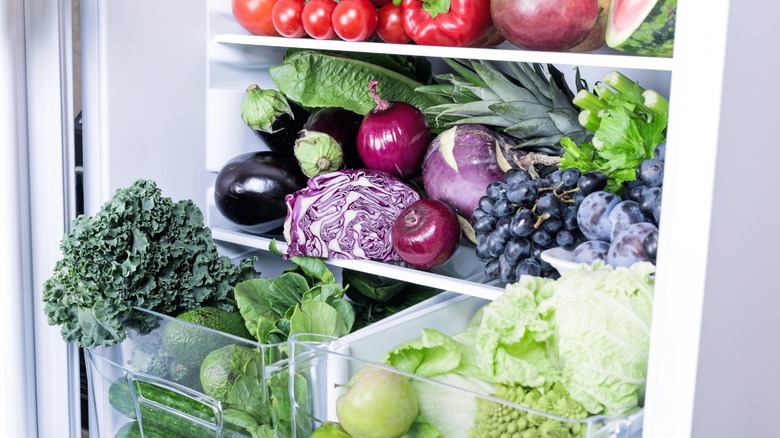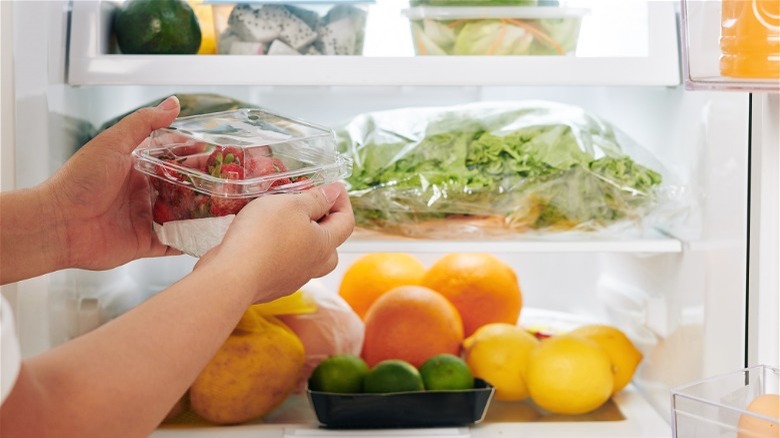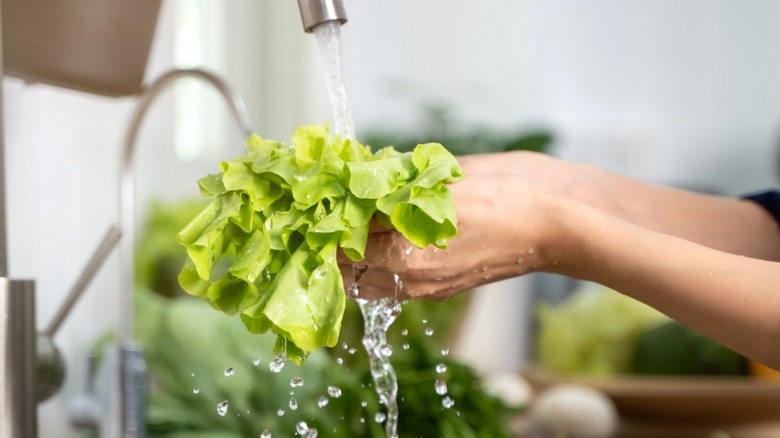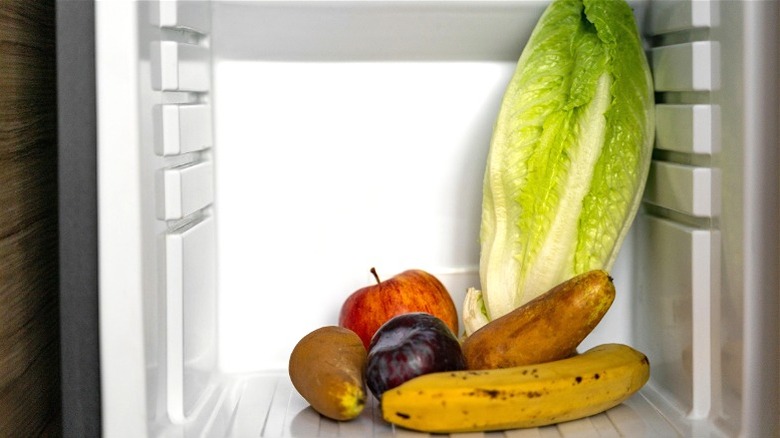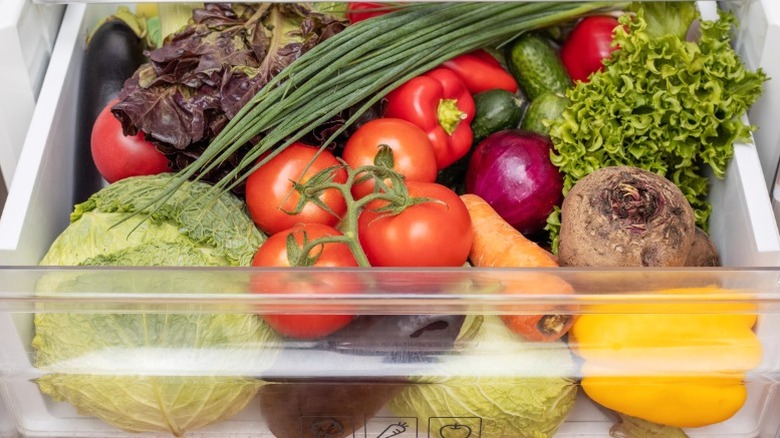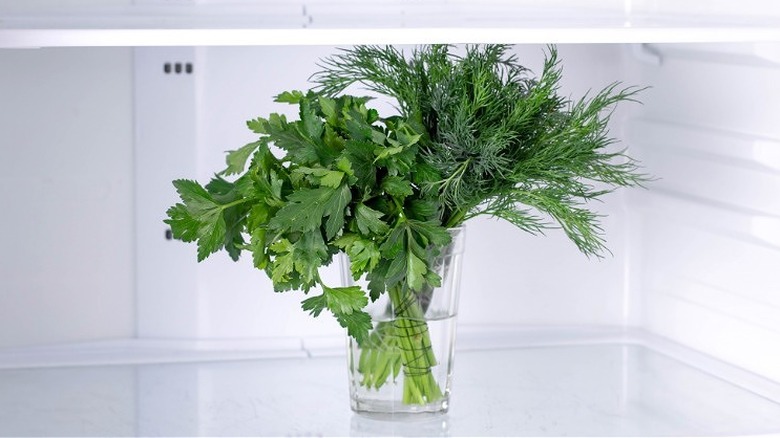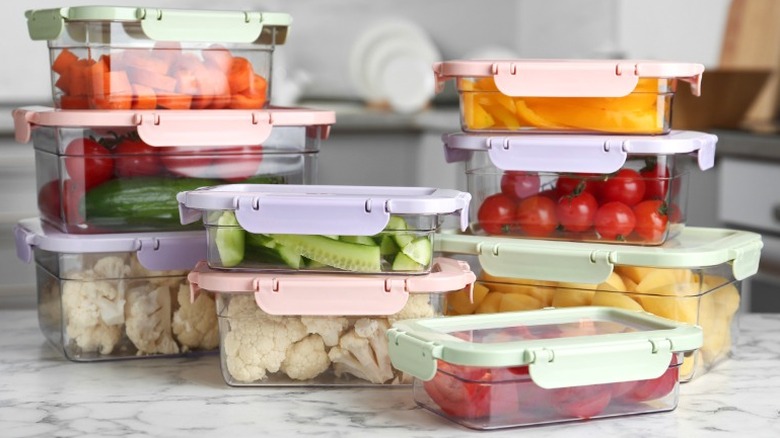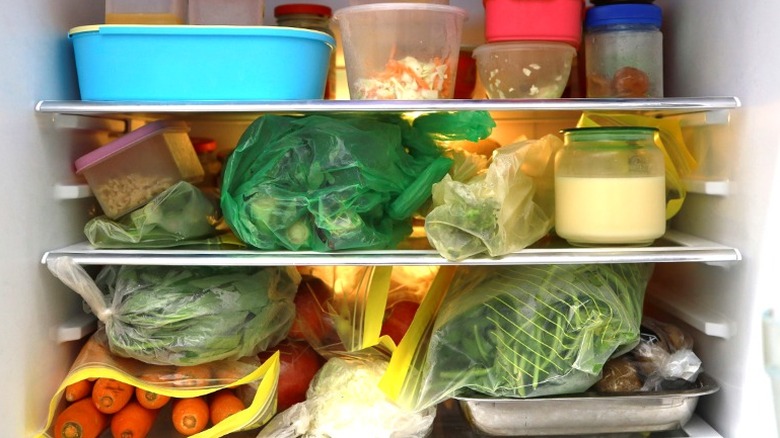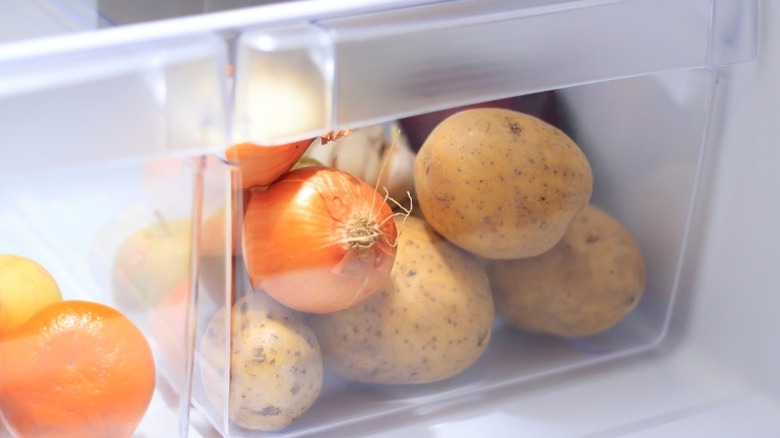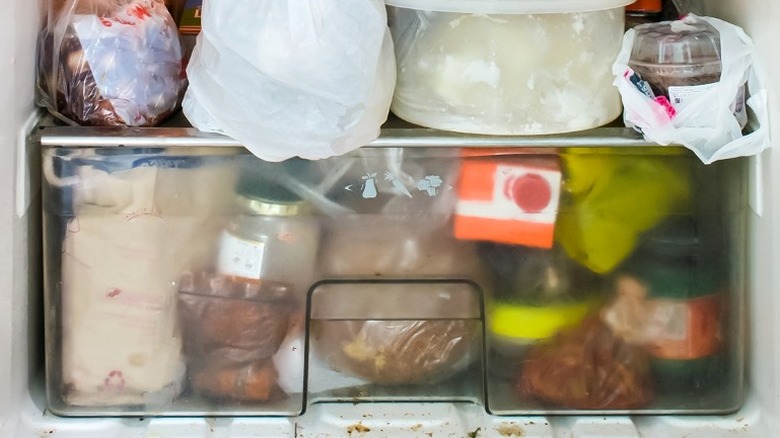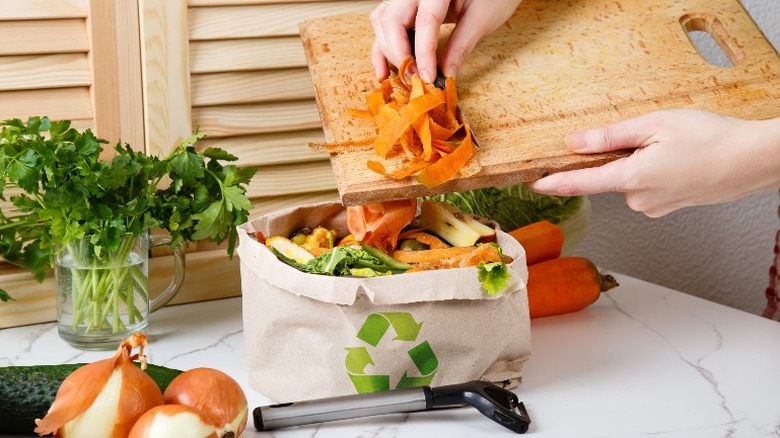10 Produce Storage Mistakes To Avoid
Reducing food waste is as important as ever: 1.4 billion tons of food is wasted annually worldwide, and the U.S. is leading the way, losing up to 30 to 40% of its food supply, (via RTS). As individuals, families, and communities, we have the power to make a big difference in the amount of food waste we produce. However, in order to do that, we need to change our relationship with food, starting with something as deceivingly easy as storage. Unfortunately, many of us make common mistakes when it comes to storing produce, leading to quicker spoilage, loss of nutrients, and avoidable food waste.
By taking simple steps, such as studying the way our fridges work, or how plant foods react with each other in storage, we can dramatically change the shelf life of foods we buy. Not only will this save us money, but it will also help reduce the amount of food that ends up in landfills, ultimately helping to protect the environment. With a few simple changes, you can avoid these common produce storage mistakes and get the most out of your produce while reducing food waste.
Storing produce in its original packaging
There's no way around it: Most produce comes in plastic. And while some of it actually benefits from the perforated see-through packaging, more often than not, plastic ruins rather than saves perishable food — just think back to all the times you've found some lettuce rotting inside a moist plastic bag in your fridge. Luckily, there are ways to keep your fruits and veggies fresh while using less plastic.
Using cloth bags both to shop and to store your produce is a more sustainable option. Not only does it reduce the amount of plastic you buy, but it also prevents your fruits and veggies from spoiling early due to "sweating." Just don't forget to clean your reusable bags often. Leafy greens and herbs are best stored in muslin bags, whereas bell peppers, Brussels sprouts, cauliflower, and eggplant would benefit from cotton or linen bags. Cotton dish towels will also do the trick, so there is no need to splurge on anything new.
In addition to keeping produce fresh longer, removing store-bought packaging is also more efficient and aesthetically pleasing. While some fridge organization aficionados swear by keeping everything in glass jars, stackable square and rectangular containers are much more space-efficient. No matter which shape or material you go for, using clear containers will help your fridge look more uniform and encourage better rotation.
Washing produce preemptively
If you're tempted to rinse off your fresh produce as soon as it arrives at your house, it's probably best to hold off. Keeping dirty produce in the fridge might seem gross, but having it rot after being washed too early or not dried properly has got to be worse. Bacteria and dirt are the main reasons for washing, so it's understandable to want to keep them away from the refrigerator, but the dampness created by washing can cause bacteria to grow. Most fruits and vegetables have likely already been scrubbed for store display, so keeping them dry until right before you use them is the best way to preserve their freshness.
Additionally, if you doubt whether you should wash pre-washed produce, there are a few things to keep in mind. According to the FDA, packaged greens are safe, but you need to be careful so as not to contaminate them yourself by exposing them to harmful bacteria from animal products via shared appliances or unwashed hands. All other produce needs to be thoroughly washed with water before consumption — but we're sure you know that already.
Pairing foods that are wrong for each other
Don't be fooled by color-coordinated fridge photos on Instagram — not all fruits and veggies can be kept together. How and where you store them is important. If your fresh produce keeps wilting, ethylene may be the cause. This gaseous hormone found in plants affects their growth and development. In other words, it's what helps them ripen. It is so potent that they even use it commercially to ensure fruits get perfectly ripe at the store.
To master home produce storage, you need to know which plants produce ethylene and which ones are sensitive to it and try to keep them apart. The rule of thumb is that fruits and vegetables should be kept separate. Bananas, melons, apples, tomatoes, and avocados are some of the ethylene-producing items, while broccoli, cucumbers, leafy greens, and peaches are ethylene-sensitive. On the other hand, most berries and citrus fruit aren't ethylene sensitive and can be safely stored next to any plant foods. The same goes for potatoes, garlic, and pineapples, but those shouldn't be refrigerated.
Another key note is whether your fruit is climacteric. These terms refer to the fruit's ability to ripen after being picked. Knowing that peaches, bananas, avocados, and apples are climacteric fruit explains why they both produce ethylene and are highly sensitive to it. So unless you want to help your avocados ripen, don't store them next to their ethylene-rich counterparts. Instead, go for the non-climacteric cherries, grapes, strawberries, and blueberries.
Picking the wrong place in the fridge
Most people tend to store their fruits and veggies in the same place. You might know it as the "produce drawer." It might even have little fruit and vegetable images on it. But don't let that fool you: Not all produce belongs in the crisper drawer, as it is alternatively known. In fact, if you don't use it properly, it could turn into a produce graveyard.
The main thing to consider is humidity. Refrigerators are designed to generate cool, dry air, which is not the best environment for perishable produce. The pull-out drawer at the bottom is the most humid place in your fridge due to limited airflow. While it's the perfect spot for thin-skinned vegetables and greens, its humid environment can be detrimental to foods that tend to rot rather than wilt. If possible, adjust the refrigerator settings to cater to both. If not, keep the less "thirsty" plants outside of the crisper drawer, closer to the back of the fridge, where it's cooler.
One more way to help keep your fruits and vegetables fresh is to make sure you don't overcrowd the crisper drawers. Leave enough space to allow the produce to breathe. Usually, the drawers work best when they are filled to about 67% of their capacity, according to Reviewed.
Not using water to keep things crisp
Few things are more disappointing than discovering a box of mushy cucumbers, a bag of slimy scallions, or a box of pitiful, shrunken carrots in your fridge. Thankfully, you don't need to put in additional time or money to avoid that. The solution is as simple as keeping veggies and fruits that are prone to wilting in water-filled containers in the refrigerator.
A good technique to maintain the freshness of herbs and scallions is to store them as if they were flowers. When doing this, it's important to rinse off the ends of the stems, taking off any dirt or slime. Make sure to put only a little water in the container; 1 to 2 inches should do it. Cover the tops with a loose plastic bag to create a greenhouse effect and prevent them from drying out and overcooling.
Carrots can also be kept fresh for weeks if submerged in water, either in a vertical or a horizontal container. Other water-rich vegetables, such as celery, will also benefit from being stored this way. Finally, while whole cucumbers will turn into a soggy mess if not kept utterly dry, sliced cucumbers will thrive in an airtight container filled with cold water. Whatever you're storing this way, remember to change the water regularly to keep the produce fresh longer.
Being too generous (or too stingy) with the knife
Batch cooking and meal prepping have been growing in popularity in the last five years as money and time-saving home food systems. Both require prepping the ingredients, or even whole meals in batches, to be enjoyed throughout the week. But while it might be more convenient to wash and chop all your veggies on Sunday and neatly pack them into containers, their shelf life will decrease. Most fruits and veggies are best kept whole and unwashed unless you plan on enjoying them right away. This also means that you probably should stay away from pre-cut fruit and vegetables.
There's one major exception to this rule. If you buy carrots, radishes, or beets in bunches, it is advised to cut off their greens before storing the roots. This is because the tops will wilt faster than the roots and will draw out moisture from the roots if they stay attached. Rather than discarding the cut-off greens, you can consume them in salads and pestos and make the most of the food you have saved.
Not rotating the food in the fridge
Have you ever wondered how supermarkets manage the abundance of perishable items they have to sell every day? Or how do restaurants make sure the food they serve is fresh? The FIFO method is the answer. This is a stock rotation system used in commercial and industrial environments that follows the concept of "first in, first out." This system applies to refrigerated and frozen items, as well as those in dry storage, ensuring that food is fresh and that waste is minimized. To apply this method at home, you need to determine the expiration date on the food, place the items with the earliest expiry date at the front, and use first the items in the front. If you wanted to reduce food waste and incorporate more produce into your diet, this is the method for you.
If you store your food in reusable containers, make sure to label them in order to monitor expiry dates. You may also place a handy printout of produce lifespans on the fridge to aid you. Lastly, remember that FIFO is an ongoing process. After each new trip to the grocery store, always rotate the food in the fridge so that older produce can be consumed before it spoils.
Refrigerating what you should keep on the counter
You might think all fresh foods belong in the fridge, but that is a misconception. It might seem counterintuitive, but keeping some fruit and vegetables out on the counter or elsewhere in your house might actually prolong their shelf life and lower your food waste. Not to mention all the fridge space you will save!
For instance, raw potatoes are among the foods you should never refrigerate. That is because the cold will affect their chemical composition, converting their starches into sugars and making them unappealing both visually and texturally. The same goes for sweet potatoes. The cold promotes sprouting and premature moldiness in onions, shallots, and garlic, so they are also best stored in a dark and dry place — just not next to potatoes or other ethylene-sensitive plants. Contrary to what their name might suggest, winter squashes dislike cool and humid environments, and neither do pumpkins. Finally, refrigerating tomatoes is a big red flag. It dramatically alters the flavor and texture and prevents it from ripening.
In terms of fruit, bananas and persimmons prefer room temperature and will enjoy countertop placement. Climacteric fruits, such as apples, mangoes, pears, avocados, and most stone fruit, will ripen quicker if left at room temperature, so if you bought them a little too firm for your liking, it's best to leave them out. If you ever have a little too much fruit, you can always freeze it or make homemade preserves.
Not cleaning the fridge
Although it seems obvious, not many of us exercise due diligence when it comes to keeping our refrigerators spotless. While it may seem a daunting task, cleaning the fridge is actually not that complicated if you do it often. It's only fair to give the main appliance in the house that much attention! Roers recommends taking the time to give those shelves a scrub each week, using a damp cloth and an all-purpose cleaner. The rubber seal on the door requires monthly cleaning, while odor removal and defrosting can be done every six to 12 months.
Added benefits of regularly cleaning your fridge include easier meal planning since you always have a general idea of the food items you have on hand. Additionally, knowing exactly what you have in your fridge might spark creativity when you mix and match ingredients. Cleaning out your fridge will boost your storage space and airflow, in addition to eliminating expired items. Finally, it has the potential to lower your food waste because regular cleaning goes hand in hand with rotation, making sure you enjoy foods before they expire.
Throwing out what you can revive
There's no better way to lower food waste than upcycling or repurposing food. Wilted greens, overripe fruit, veggie scraps — all of those could end up in the compost bin or, much worse, in the trash. Or, they could get a second life. Root-to-stalk cooking has been gaining traction in the past decade, and for a good reason: There's something inherently satisfying in creatively reusing what would otherwise be thrown out.
There are countless ways you could save fresh produce that's past its prime. For one, you could revive it. Wilted greens or limp vegetables could be brought back to life by a refreshing ice bath. Alternatively, you could preserve it: Overripe fruits and berries make great jams or compotes. Finally, you can cook with it: Unless it's moldy and clearly rotten, most wilted or overripe produce is safe to eat and can work well in various recipes. Old spinach would make a great addition to scrambles and soups; limp vegetables could be cut up and baked into a quiche, and even a brown-fleshed avocado can be turned into a creamy chocolate mousse!
